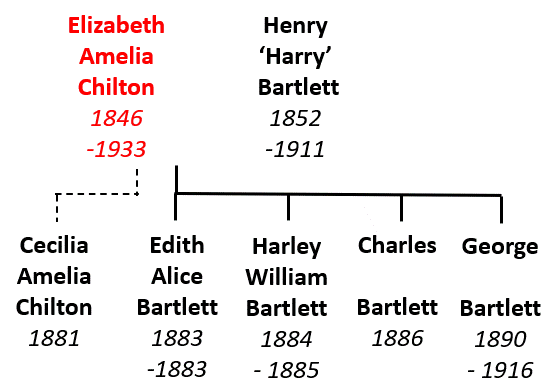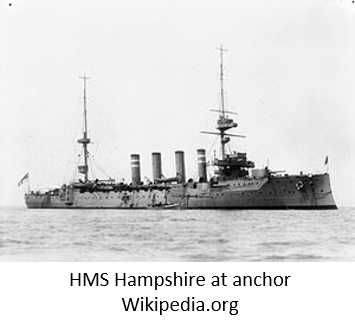elizabeth amelia chilton
Subject Name : Elizabeth Amelia Chilton (b 1846 – d 1933)
Researcher : Jo Patrick
Plumber’s daughter Elizabeth Amelia Chilton spent her early years in Kensington, London, before moving to Wonersh where she was a domestic servant. She was an unmarried mother in the Guildford Union Workhouse at the age of 35 but went on to marry twice, the second time when she was 76. Elizabeth had five children, one of whom died in one of the most infamous incidents of World War 1, the sinking of HMS Hampshire in 1916 which also claimed the life of Field Marshal Lord Kitchener, Britain’s Secretary of State for War, and over 730 crew.
Elizabeth was born on 22nd January 1846 at the family home of 4 Kinnerton Street,  Kensington, London. Her parents were William Chilton, a plumber from Bristol, and Sarah née Batchelor from Wonersh, Surrey. Elizabeth was baptised on 1st May at nearby St Saviour’s Church, Upper Chelsea. She was the sixth of seven children, although two older brothers had died before she was born.
Kensington, London. Her parents were William Chilton, a plumber from Bristol, and Sarah née Batchelor from Wonersh, Surrey. Elizabeth was baptised on 1st May at nearby St Saviour’s Church, Upper Chelsea. She was the sixth of seven children, although two older brothers had died before she was born.
At the time of the 1851 Census, 5-year-old scholar Elizabeth and her family were at 34 Kinnerton Street. Her father William was listed as a ‘plumber/glazier’.
Family split?
Elizabeth’s mother Sarah gave birth to her final child Archibald John in early 1853 at Kinnerton Street. The 1856 Post Office Directory listed Elizabeth’s father William as still at the same address, but the 1861 Census raises questions which remain unanswered.
That Census records Elizabeth’s mother Sarah living with only her 8-year-old son Archibald in D’Oyley Street, a short walk from Kinnerton Street. Elizabeth’s brother William was lodging in Turk’s Row, Chelsea, also close to Kinnerton Street, while sister Emily was working in Cornwall.
Elizabeth, now 15, her father William and her eldest sister Sarah have not been traced, and the 1861 Census return for Kinnerton Street, has not been located. They may have been at Kinnerton Street or indeed anywhere else, but why were mother Sarah and brother Archibald living apart from them?
Elizabeth moves to Shamley Green
Whatever the reasons for the apparent family separation, the 1871 Census showed that Elizabeth, now 24, and her 27-year-old brother William were back together and had moved to Shamley Green, close to their mother’s birthplace of Wonersh, living with their 69-year-old unmarried uncle, Benjamin Batchelor, a master shoemaker. Elizabeth was a domestic servant, although whether this for her uncle or she was working elsewhere is not clear. William was noted as a seaman in the Royal Navy, but he would have been at the end of his service having enlisted for 10 years from his 18th birthday in April 1861.
This Census also showed that Elizabeth parents were together again and living in Bloomsbury, West London. Her father was no longer a plumber, but a porter, and the couple had two lodgers to supplement their income.
Ten years later, at the time of the April 1881 Census, Elizabeth was an inmate of the Guildford Union Workhouse, unmarried, with her occupation ‘domestic servant’ . Her admission was of a ‘temporary character and not of permanent illness or disability’. The Guildford Union Board of Guardians had instructed that ‘an order be obtained without delay for her removal to Hambledon Union’ because Elizabeth’s family was from the Hambledon parish of Wonersh, although she herself had been living in the Guildford parish of Albury at the time.
The somewhat delicate phrase ‘temporary nature’ meant that Elzabeth was pregnant, as she gave birth at the age of 35 to her first child Cecilia Amelia Chilton on 14th May 1881 in the Guildford Union Workhouse, so clearly the order to remove her to Hambledon had not happened. No father was named on the birth certificate.
Marriage and a move to the South Coast
There are no records to show when Elizabeth and Cecilia left either the Guildford or Hambledon Workhouse, but about 18 months later, Elizabeth married Farnham-born Harry (Henry) Bartlett from Shamley Green.
Their first child Edith Alice was born in March 1883 at Lawnsmead, Wonersh. On her birth certificate, Harry was a ‘leather dresser (journeyman)’, so he was probably working at nearby Lostiford Mill situated between Shamley Green and Wonersh.
Edith only lived for 8 weeks, passing away at home on 22nd May in Lords Hill Common, just to the west of Shamley Green, from ‘convulsions’. Two days following Edith’s death, Elizabeth’s first daughter Cecilia was baptised with the surname Bartlett, and parents Harry and Elizabeth at Christ Church, Shamley Green. There is no burial entry for Edith, but it seems likely that her funeral would have taken place at the same time as Cecilia’s christening on 24th May, and that the burial was missed off the parish register by mistake.
 Elizabeth and Harry suffered again when their first son Harley William died aged 2 months in January 1885 in Hambledon Union Workhouse.
Elizabeth and Harry suffered again when their first son Harley William died aged 2 months in January 1885 in Hambledon Union Workhouse.
Their next child, Charles, was born in Castle Street, Guildford in January 1886 and did go on to survive his childhood.
Elizabeth and Harry decided to move to Newhaven on the south coast of Sussex, where Elizabeth gave birth to her fifth and final child George in 1890. What prompted Harry and Elizabeth to move to Newhaven is unknown. Perhaps there was more work to be had in the docks than there was available in Surrey.
The 1891 Census showed the family living at 8 Lower Elphick Road, Newhaven. Harry was employed as a ‘dock quay labourer’. Daughter Cecilia was 9, son Charles 6, and baby George 6 months.
They had moved across town to 6 Clifton Terrace by the time of the 1901 Census with Harry still a labourer at the docks. Son Charles, 15, was a ‘golf caddie’, with 10-year-old George ‘attending school’. They also had another dock worker lodging with them.
Elizabeth’s daughter Cecilia was a live-in servant in Tonbridge, Kent, in 1901, but returned to Newhaven, marrying labourer William Lower on Christmas Day 1903. Cecilia named Harry as her father, although there is no other record to verify this was true.
The 1911 Census showed 65-year-old Elizabeth to be visiting Cecilia, William, and her three young grandchildren at 19 Evelyn Avenue, Newhaven. Elizabeth had made the short walk from her home in Albion Place alone, as husband Harry was a patient in the Newhaven Workhouse Infirmary. The date of the Census was 2nd April, and just 26 days later, Harry passed away in the Infirmary from ‘carcinoma of the larynx’.
Son George lost at sea in WWI
The month following his father’s death, Elizabeth and Harry’s son George enlisted with the Royal Navy Volunteer Reserve. Aged 19, he was called into action following the outbreak of World War 1 in August 1914. He served on a number of ships before transferring to armoured cruiser HMS Hampshire in August 1915.
 HMS Hampshire was briefly involved at the end of May 1916 in the Battle of Jutland off the Denmark coast, the largest naval battle of the War.
HMS Hampshire was briefly involved at the end of May 1916 in the Battle of Jutland off the Denmark coast, the largest naval battle of the War.
After the two-day battle, the ship returned to Scapa Flow in the Orkney Islands in order to take Field Marshal Lord Kitchener, Britain’s Secretary of State for War, for talks with Russia’s Tsar Nicholas II.
 HMS Hampshire left Scapa Flow on 5th June, but just a short time later, it struck a German mine off Orkney’s north-west coast and sank with the loss of 737 lives, including those of Kitchener and Elizabeth’s son, 25-year-old George. Only 12 crew members survived. George’s body was one of many not recovered or identified, but he is among those commemorated at the Lyness Naval Cemetery on Hoy, Orkney Islands and on the Portsmouth Naval Memorial.
HMS Hampshire left Scapa Flow on 5th June, but just a short time later, it struck a German mine off Orkney’s north-west coast and sank with the loss of 737 lives, including those of Kitchener and Elizabeth’s son, 25-year-old George. Only 12 crew members survived. George’s body was one of many not recovered or identified, but he is among those commemorated at the Lyness Naval Cemetery on Hoy, Orkney Islands and on the Portsmouth Naval Memorial.
Elizabeth was living in Blatchington, a short distance east of Newhaven, when her son died. By the time of the 1921 Census she had returned to Newhaven, lodging at 45 Elphick Road. Elizabeth clearly got on well with at least one of her neighbours, as early the following year, she married Thomas Novis, living at number 49. He was a widowed retired bricklayer, aged 78, a couple of years older than Elizabeth.
They remained together at 49 Elphick Road, where Thomas died in 1930, aged 87. Elizabeth lived there for another three years, passing away from heart disease on 3rd November 1933, also aged 87.
October 2019, updated January 2025
 Spike Lives is a Heritage project that chronicles the lives of inmates, staff and the Board of Guardians of the Guildford Union Workhouse at the time of the 1881 Census. The Spike Heritage Museum in Guildford offers guided tours which present a unique opportunity to discover what life was like in the Casual/Vagrant ward of a Workhouse. More information can be found here
Spike Lives is a Heritage project that chronicles the lives of inmates, staff and the Board of Guardians of the Guildford Union Workhouse at the time of the 1881 Census. The Spike Heritage Museum in Guildford offers guided tours which present a unique opportunity to discover what life was like in the Casual/Vagrant ward of a Workhouse. More information can be found here
Sources
Ancestry.co.uk
General Register Office GRO.gov.uk
Shamley Green History Society SGmatters.co.uk
Surrey History Centre Surreycc.gov.uk
The National Archives Discovery.NationalArchives.gov.uk
Wikipedia.org
Workhouses.org.uk
For a full list of references click here
